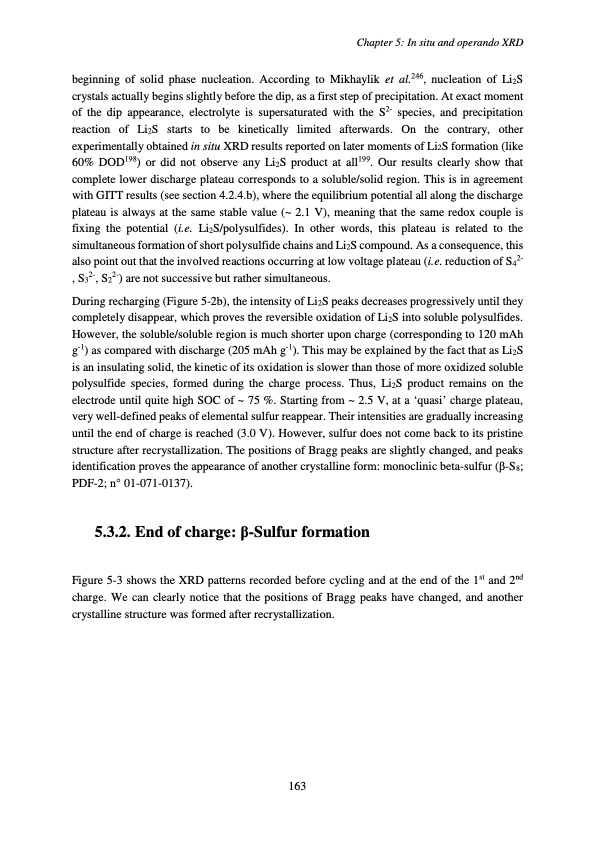
PDF Publication Title:
Text from PDF Page: 167
beginning of solid phase nucleation. According to Mikhaylik et al.246, nucleation of Li2S crystals actually begins slightly before the dip, as a first step of precipitation. At exact moment of the dip appearance, electrolyte is supersaturated with the S2- species, and precipitation reaction of Li2S starts to be kinetically limited afterwards. On the contrary, other experimentally obtained in situ XRD results reported on later moments of Li2S formation (like 60% DOD198) or did not observe any Li2S product at all199. Our results clearly show that complete lower discharge plateau corresponds to a soluble/solid region. This is in agreement with GITT results (see section 4.2.4.b), where the equilibrium potential all along the discharge plateau is always at the same stable value (~ 2.1 V), meaning that the same redox couple is fixing the potential (i.e. Li2S/polysulfides). In other words, this plateau is related to the simultaneous formation of short polysulfide chains and Li2S compound. As a consequence, this also point out that the involved reactions occurring at low voltage plateau (i.e. reduction of S42- , S32-, S22-) are not successive but rather simultaneous. During recharging (Figure 5-2b), the intensity of Li2S peaks decreases progressively until they completely disappear, which proves the reversible oxidation of Li2S into soluble polysulfides. However, the soluble/soluble region is much shorter upon charge (corresponding to 120 mAh g-1) as compared with discharge (205 mAh g-1). This may be explained by the fact that as Li2S is an insulating solid, the kinetic of its oxidation is slower than those of more oxidized soluble polysulfide species, formed during the charge process. Thus, Li2S product remains on the electrode until quite high SOC of ~ 75 %. Starting from ~ 2.5 V, at a ‘quasi’ charge plateau, very well-defined peaks of elemental sulfur reappear. Their intensities are gradually increasing until the end of charge is reached (3.0 V). However, sulfur does not come back to its pristine structure after recrystallization. The positions of Bragg peaks are slightly changed, and peaks identification proves the appearance of another crystalline form: monoclinic beta-sulfur (β-S8; PDF-2; n° 01-071-0137). 5.3.2. End of charge: β-Sulfur formation Figure 5-3 shows the XRD patterns recorded before cycling and at the end of the 1st and 2nd charge. We can clearly notice that the positions of Bragg peaks have changed, and another crystalline structure was formed after recrystallization. 163 Chapter 5: In situ and operando XRDPDF Image | Accumulateur Lithium Soufre

PDF Search Title:
Accumulateur Lithium SoufreOriginal File Name Searched:
WALUS_2015_archivage.pdfDIY PDF Search: Google It | Yahoo | Bing
Sulfur Deposition on Carbon Nanofibers using Supercritical CO2 Sulfur Deposition on Carbon Nanofibers using Supercritical CO2. Gamma sulfur also known as mother of pearl sulfur and nacreous sulfur... More Info
CO2 Organic Rankine Cycle Experimenter Platform The supercritical CO2 phase change system is both a heat pump and organic rankine cycle which can be used for those purposes and as a supercritical extractor for advanced subcritical and supercritical extraction technology. Uses include producing nanoparticles, precious metal CO2 extraction, lithium battery recycling, and other applications... More Info
| CONTACT TEL: 608-238-6001 Email: greg@infinityturbine.com | RSS | AMP |